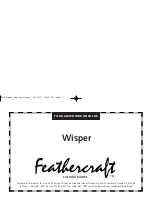
PAGE 18
MARINA DOCKING
For marina docking, the shrouds are released from
the floats and the floats folded as normal. The marina
slip can then be entered and the folded boat moored
as with any other craft. However, care must be taken
if high cross winds are a possibility, as folded stability
is limited. Precautions include running a line from the
mast to the dock on each side, a wider folded position,
or lowering the mast in extreme conditions.
One problem with marina docking is stains or growth
on the lower float sides. This is not a major problem
with short stays in a slip, but will be a nuisance over a
long period. There are several ways to overcome this,
one being the use of an antifouling wax on the float
sides. Thus the gelcoat finish is preserved and only an
occasional wipe is needed. Antifouling paint could also
be applied to the float sides but this is not attractive, it
needing to be 2’ 6” wide.
One of the best and recent solutions for long term
marina docking is a dock liner, which surrounds the
boat with sterilized water, preventing growth.
SAFETY
The modern trimaran with its enormous stability
and unsinkability is a very safe craft and has now
established an excellent safety record. However, this
safety is dependent on the operator and how the craft
is handled.
The major hazard to be avoided is capsizing. This is
rare with well sailed multihulls but can occasionally
occur with racers pushing it to the limit. Sail too fast for
the conditions and the risk of capsizing is higher.
In general, the risk factor will only begin to increase
when boat speed exceeds 15 knots while reaching
or about 10 knots windward. When sailed for the
conditions, or with safety in mind, Corsairs are the
safest craft afloat.
UNSINKABILITY
This is the ultimate safety feature for any boat. All
Corsair models are unsinkable being constructed
almost completely in foam/glass with multiple
watertight compartments. With no heavy keel, it is
therefore immune from sinking, even with all watertight
compartments flooded.
There are 9 watertight compartments, including:
¡
Floats
¡
Forward collision compartment
¡
Storage locker
¡
Under cockpit floor
¡
The four beams
CAPSIZE
Capsize is always a possibility even if a remote one and
should it ever occur, stay calm and make sure all crew
are accounted for. Anything stored within the storage
locker will remain dry and undamaged
RIGHTING
When the opportunity arises and outside assistance is
available, the most successful system for any multihull,
is to tow the capsized boat fore and aft. Depending
whether the stern or bow is lower in the water will
determine where you attach your tow line bridle, so
make sure you choose the end that is floating highest.
You may need to use a second bridle line and attach
this to the beams that are closest to the tow vessel
(see Dia). These lines will prevent the vessel slewing off
line as you right the vessel. As you begin to right your
vessel you will need to ease these lines.
If the above procedure does not work, then try flooding
the end that needs to sink, or add some crew weight
(ready to abandon ship once the end concerned starts
to go under). If this fails, try towing the other direction.
Some controlled flooding may also be required. Towing
sideways will not work.
Righting your vessel using the following folding system
is as follows:
Righting Procedure
PERSONAL RESPONSIBILITY
There have been exhaustive efforts to minimize the risk
of personal injury, loss, or any other form of damage,
while operating a Corsair built trimaran but obviously it
is impossible to completely eliminate every risk. Deck
gear cannot be made trip proof, nonskid can wear
and cause slipping, rigging wires can be kinked while
rigging and later fatigue, lifelines can be fallen over,
groundings at speed can cause eventual dagger board
or rudder failure, neglect of proper maintenance can
cause early failure and lack of experience can cause
accidents in congested areas or bad conditions. Sailing
can be hazardous at times and the boat operator
should accept responsibility for all such hazards.
Many of these risks have been covered in this manual,
but obviously it is impossible to cover them all. Some
recommended procedures may not even be the
correct ones in certain situations. The operator should
therefore always be vigilant against all possible safety
https://www.boat-manuals.com/







































